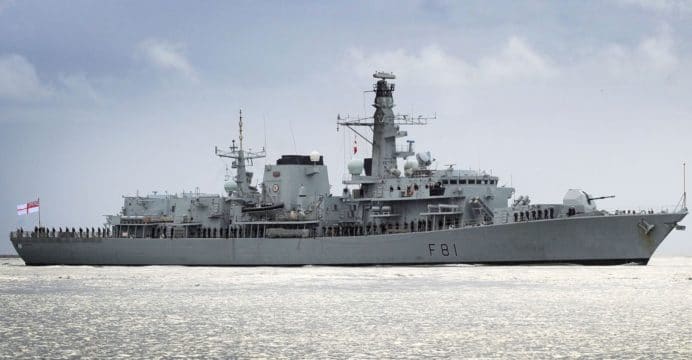It was reported earlier in the week that Brazil and Chile were considering purchasing Royal Navy warships, the MoD has denied this.
An MoD spokesperson said:
“We can categorically confirm that there has been no engagement with either Chile or Brazil in respect of early sale of Type 23 Frigates or the two LPDs.”
Most notably reported by IHS Jane’s Navy International, it was claimed by the outlet that Brazil and Chile have
“quietly been given notice of the potential availability of RN frigates and amphibious ships”.
Janes
that UK officials have “discreetly advised” that some of the frigate fleet in addition to the two Albion class landing platform docks could become available due to budget cuts.
Recently we received a press release from the MoD claiming that the Royal Navy is
“growing for the first time since the Second World War”. Make of that claim what you will.
This comes not long after the Brazilian Navy reportedly sent a proposal to pay for helicopter carrier HMS Ocean in instalments.
According to Brazilian journalist Roberto Lopes in an e-mail to us, the ship’s cost to the Brazilian Navy is fixed at £80.3 million pounds (312 million of Brazilian Reais).
Commander of the Brazilian Navy, Admiral Eduardo Leal Ferreira, claimed that the price of Ocean seemed “convenient”.
HMS Ocean is the UK’s only helicopter carrier and the fleet flagship of the Royal Navy. She is designed to support amphibious landing operations and to support the staff of Commander UK Amphibious Force and Commander UK Landing Force.
According to someone we spoke to currently on-board the vessel, there are rumours that this is one of a number of possibilities:
“People have been talking about what will happen to the ship after 2018, there were rumours that the vessel might be sold to another navy but there’s been no mention of what navy that might be.”
The helicopter carrier was constructed in the mid-1990s and commissioned in September 1998.
This comes not long after recent Government and MoD press releases regarding the Royal Navy made claims that the Royal Navy is “growing for the first time since the Second World War”, those claims have now vanished.
In one of the most notable releases republished across a few government pages regarding the naming of HMS Medway (
), the Government claimed:
“The OPV programme is sustaining around 800 jobs in Scotland at BAE Systems and is maintaining the vital skills needed to build the new cutting-edge, anti-submarine warfare frigates, the Type 26s, for a Royal Navy growing for the first time since the Second World War.“
However, in
, that claim has rightfully been edited out and only a quote by Fallon remains making a similar albeit not as outlandish claim.
We even tweeted about this earlier in the Month.
It would appear that standalone references to a growing Royal Navy have decreased across the board with the remaining examples that we could find being included in quotes by officials and therefore, not really all that removable.
Earlier today, we reported on potential plans to cut the number of Type 23 Frigates (one of the type is pictured at the top of this article) in Royal Navy service,
Recently, we drew attention to claims made by multiple ministers, MP’s and other officials that continue to insist the Royal Navy is growing.
This isn’t true according to the the
document released by the Government detailing statistics on vessels, land equipment and aircraft of the armed forces. It states:
“At 1 April 2017 there were 73 vessels in the UK Armed Forces: 64 vessels in the Royal Navy and nine in the Royal Fleet Auxiliary (RFA). This is a reduction of three vessels since 2016 following the withdrawal of three RFA vessels: two Small Fleet Tankers and one Forward Repair Ship (RFA Diligence).
Patrol Ships (18 Inshore and four Offshore) make up the largest proportion of Royal Navy vessels, with 22, as shown in Chart 1 below.
The total number of Destroyers and Frigates (19) as at 1 April 2017 are also in line with SDSR Joint Force 2025 commitments.”
Further, according to the Defence Select Committee, the UK has a “woefully low” number of warships. Chair of the committee Dr Julian Lewis advised earlier in the year that the Government risked leaving the country with fewer than 19 frigates and destroyers.
“The United Kingdom will then lack the maritime strength to deal with the threats we face right now, let alone in the future. We are putting the MoD on notice that it must not let this happen.”
Additionally, Sir John Parker the author of an independent report on the National Shipbuilding Strategy, has indicated that the frigate fleet will fall below 13 frigates unless the Type 31 Frigate build starts soon, something that appears unlikely for a project described by a minister this month as still in “early pre-concept phase” with no design having yet been chosen.
Julian Lewis asked during a Defence Select Committee session on the National Shipbuilding Strategy:
“So what you are saying—and this is a critical point—is that unless we start building the Type 31e frigates in parallel with the Type 26s, there is little chance of not reducing below our existing figure of 13 frigates all told.”
Sir John Parker responded with one word:
“Correct.”
13 frigates are due to leave the service at a rate of one a year between 2023 and 2035. There remains serious concern about the funding and timetable of the fleet that will replace them.
There is also fresh speculation that the Royal Navy will lose the two Albion class landing platform dock vessels. Among other speculated cuts is a reduction of 1,000 to the Royal Marines and the retirement of two minehunters and one survey vessel.
The loss of more ships isn’t growth, no matter who is tallying it up.

